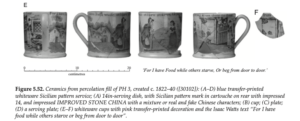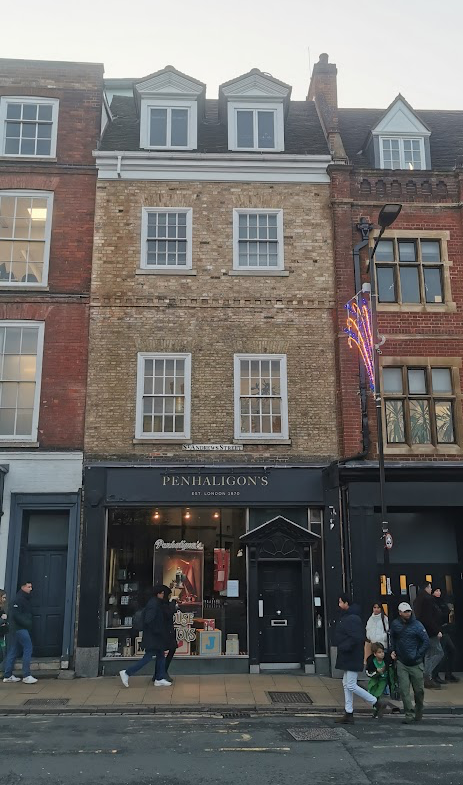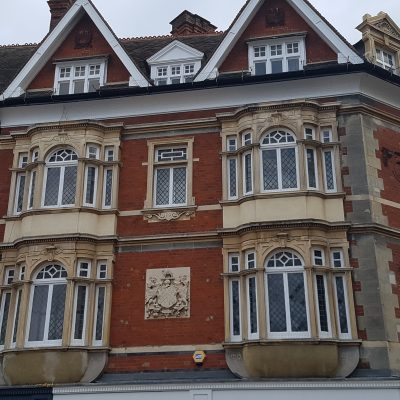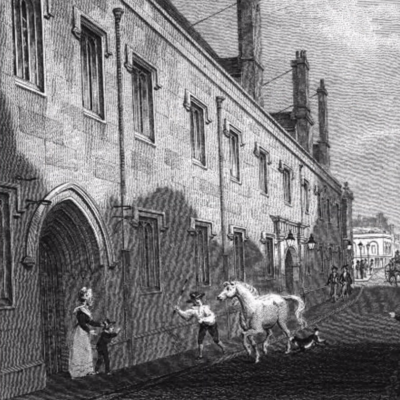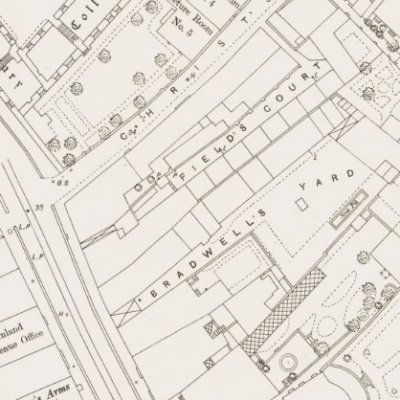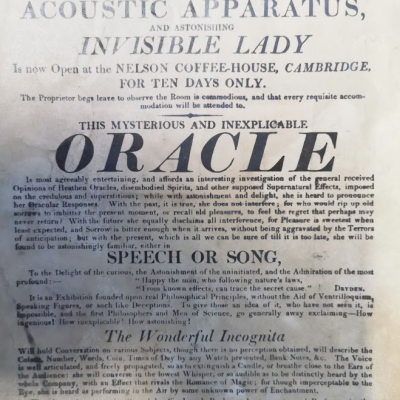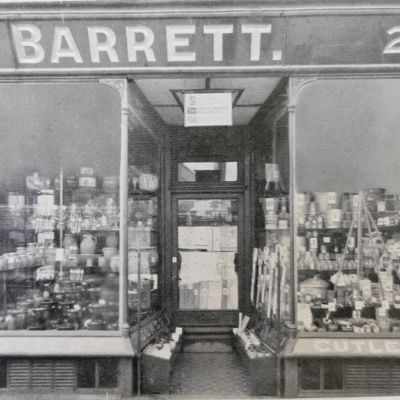Search by topic
- archaeology
- Building of Local Interest
- charity
- church
- crime
- dressmaker
- fire
- Great Eastern Railway
- Listed building
- Mapping Relief
- medieval
- oral history
- poverty
- Public House
- Rattee & Kett
- Religious House
- Roman
- scholar
- school
- Then and Now
- tudor
- women
- work
- world war one
- world war two
Search by text
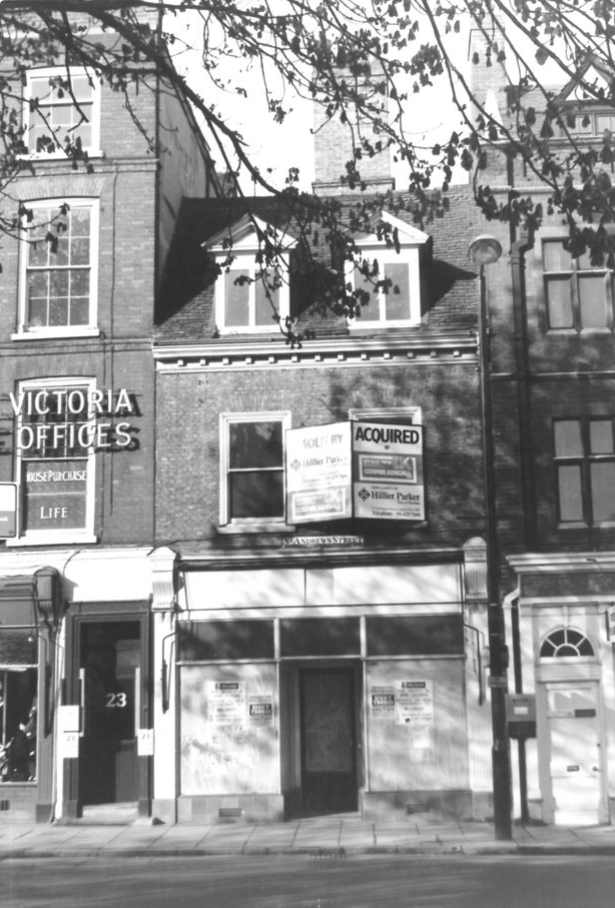 22 St Andrew's Street c1960 (MoC102.72)
22 St Andrew's Street c1960 (MoC102.72)22 St Andrew’s Street
History of 22 St Andrew's Street
1959 Royal Commission on Historical Monuments Survey of Cambridge describes this as a house of two storeys built c. 1730. The shop-front is of late 19th century. Access to the first floor is now by a stair in the adjoining building.
1841
Sarah Dobson ran a school at this address from at least. She was born in 1796 and came from a farming family. Archaeological finds during the Grand Arcade excavation are noted in the report (2019) p.273 covering the finds in Plot XIV:
This group dominated by dining-related material and indicates that the adults in the Dobson household used a range of relatively high-quality blue transfer-printed dining and tea drinking ‘services’, suggesting that Sarah subscribed to developing ideas of domesticity and gentility (Fitts 1999). The Sicilian pattern was the most common and the literary associations of this design suggest that Sarah Dobson may have supported both the traditional moral values such as honour and integrity and the political message concerning the oppression of women in patriarchal society that the pattern could have conveyed. The children used cups decorated with images and text from the song ‘Whene’er I take my walks abroad’ by Isaac Watts , a leading early eighteenth-century non-conformist hymn-writer, theologian and logician whose straightforward and relatively gentle Christian ideas and lilting metre were popular in the nineteenth century. Matching cups and saucers were apparently discarded when one was broken reinforcing the notion of ‘services’, while the presence of three complete blacking bottles suggests a greater than normal interest in cleanliness and appearance.
The substantial animal bone assemblage that was recovered indicates a preference for the moderately expensive topside or silverside cuts of beef, shoulders of mutton and legs of pork. Pork was one of the most expensive meats at the time and is much commoner in this group than in others of this date (17.5 per cent of the meat from the main domesticates versus 0–9.7 per cent in other assemblages). As pigs were still being raised in the plot, the pork was potentially not all obtained commercially. There were also parts of at least 22 birds, the largest number from any assemblage, with 12 chicken carcasses as well as other domestic poultry, waterfowl, pigeon and game birds including red grouse, grey partridge and pheasant. Only three clay tobacco pies were present; however, the ratio of pipes to ceramic vessels (1:18) is not significantly lower than other assemblages of c. 1800–50 (1:14).
It therefore appears that despite smoking being a gendered activity associated with men, and supposedly only undertaken by women of loose morals or low status, it took place in the Dobson household. There was also evidence for the consumption of alcohol, notably two wine glasses from a matching ‘service’ and some utility bottles, two of which are French or Belgian imports and are likely to have contained wine. At the time male working class drinking culture centred upon public houses, which respectable women did not frequent. The smoking and alcohol drinking in the Dobson household suggest that private female consumption was taking place within the home, despite the fact that both activities would have been disapproved of in more public contexts.
Other garden features including PB 17 and PH 1, plus a nearby posthole, contained a child’s cup with a text from ‘Innocent Play’, another song by Isaac Watts, as well as 17 slate pencils . The pencils are 32–75mm long and have been heavily used and repeatedly sharpened. There were no identifiable writing slates, despite the presence of the pencils, and other items frequently associated archaeologically with nineteenth-century childhood such as dolls, tea sets, metal toys, marble stoppers (Wilkie 2000) were absent. This may indicate that the school was a relatively austere establishment; alternatively, it could just be that disposal was limited
1851
George Dobson
Sophia Dobson, 23
Margaret, aunt, 47, schoolmistress, b Stow Cum Quy
Lois Ann Foster, 33, teacher, b Beds
Elizabeth Baker, boarder pupil, 19, b Comberton
Harriett Baker, boarder pupil, 19, b Comberton
Elizabeth Aufor, boarder pupil, 15, b Great Eversden
Elizabeth S Childs, boarder pupil, 15, b Norfolk
Susannah Deon, servant, 17, b Stow Cum Quy
Sophia Noble, servant, 20, b Stow Cum Quy
1861
Margaret Dobson, 61, school mistress, b Stow Cum Quy
Sarah, sister, 68, invalid, b Stow Cum Quy
Kate, niece, 35, teacher, b Stow Cum Quy
Sophia, niece, 33, teacher, b Stow Cum Quy
Catherine Hall, 13, pupil, b Landbeach
Emily Theed, 9, pupil, b Stilton
William Sheed, 7, pupil, b Stilton
Ernest Sheed, 6, pupil, b Stilton
Anne Tweed, 22, housemaid, b Moulton
Herbert Hall, 9, pupil, b Landbeach
Mary Townsend, 20 servant, b Moulton
Albert G Bene, 7, pupil, b Australia
From the 2019 archaeological report p 278:
By 1865–6 Sarah Dobson had moved to smaller premises a short distance away at 7 St Andrew’s Hill, which only had a small yard or garden. Sarah died in 1886 and was interred alongside her sister Margaret who had died in 1870; her nieces Sophia and Katie were later interred in the same burial plot in 1910 and 1913. In 1885 the plot was depicted as having an ‘L’-shaped formal garden with trees, paths, regularly arranged beds and a pump, and it appears that this was largely how the garden had been when the plot was occupied by the school. It would be tempting to interpret the school garden as a pleasant, almost bucolic, location for the staff and students. This is, however, counter-pointed by the raising of pigs to eat and the presence of the WC block, apparently located so as to be concealed from the main frontage building but visible from most of the garden. This tension is paralleled in the material culture, for while ideas of gentility meant that cups and saucers were discarded when the corresponding element in the service was damaged, there was also a strong element of frugality, again exemplified by the raising of pigs but also by the slate pencils which were repeatedly sharpened so that they could be used as intensively as possible before disposal.
1871
John Christmas, 48, solicitor, b Cambridge
Sarah Richardson, 55, servant, b St Ives
1881 Solicitors office
John Christmas, 55, solicitor, b Cambridge
Sarah Richardson, 64, servant, b Hunts
Emmeline Hales, 26, servant, b Herts
1891
John Saunders Christmas, 68, solicitor, b Cambridge
Elizabeth A Moore, 28, housekeeper, b Linton
Ada Forsdyke, 16, servant, b Cambridge
This plot was unusual in that it had a garden in use until the 1970s. It was last surviving garden in the street block.
2018 Penhaligon’s
Contribute
Do you have any information about the people or places in this article? If so, then please let us know using the Contact page or by emailing capturingcambridge@
License
This work is licensed under CC BY-NC-SA 4.0





